Every living being needs water to survive — including cannabis. Believe it or not, many cultivators suggest cannabis plants are made up of 80 percent H2O! Since hydration is crucial to proper plant development, it makes sense that indoor gardeners are very concerned about their watering schedule.
While it might seem like watering marijuana would be an “exact science” at this point, there aren’t many specific guidelines new growers could follow. Proper cannabis watering depends on many variables, including your soil type, temp & humidity, and your strain’s stage of development.
Watering Cannabis — Tips For Setting A Weed Watering Schedule
Figuring out the “right” watering schedule indoor weed may take time and experimentation. However, if you know the typical signs of well-hydrated weed, you should easily determine when to break out your watering pot.
So, How Often Should I Water My Cannabis?
New cultivators often crave a simple & fast formula for weed watering. Unfortunately, it’s impossible to determine a precise weed watering strategy that works in every situation. Figuring out when to water your indoor cannabis largely depends on how dry your soil feels and how light your pots are.
The “tried-and-true” method to tell when your plant needs watering is to feel the topsoil with your fingers. If your soil feels dry to the touch, chances are good it could use a bit of water. However, if the soil in your cannabis container is still moist, it’s too early to grab your watering can.
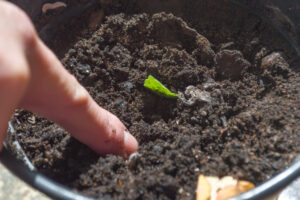
If you’re still hesitant to water your cannabis after the “finger test,” you could lift your container and get a sense of its weight. The lighter your pot’s pot feels, the more likely it could use extra water.
While these two tests may seem “unscientific,” they’re the most common ways cannabis cultivators decide when to water their plants. New cultivators should habitually use these methods when inspecting their plants at all stages of development.
It’s always best to use your five senses to determine when to water your plants, but we understand new growers need a “timeframe” to keep in mind. So, it’s best to plan on watering your weed about every two days. This will fluctuate depending on your pot’s size and your cannabis plant’s maturity, but it’s generally best to stick with this two-day check-up.
Do Cannabis Strains Need Different Water Levels At Different Stages?
As we’ve hinted above, cannabis has different water requirements throughout its lifecycle. Delicate seedlings generally do best with more frequent low-volume watering sessions. Vegetative plants need the most water, with an average of one watering session every two days. Flowering plants may also do well with a watering session every two days, but don’t be surprised if it takes three days before your soil feels dry enough for watering.
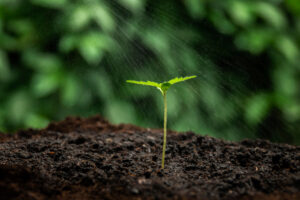
Please remember that seedlings don’t have a developed root system, so they can’t store or absorb as much water under the soil. During these early stages of development, your plants will absorb water from the air. This is why the seedling phase needs higher humidity levels versus vegetative and flowering. Indoor cultivators should consider using a spray bottle during the seedling phase to avoid oversaturating these plants.
How Can Growers Tell Their Soil Is Overwatered?
Most first-time cannabis cultivators seem to believe that “more water is better.” Don’t get us wrong: Water is essential for cannabis growth. However, chances are more likely indoor weed growers will overwater their plants rather than underwater them.
Giving your cannabis plants too much water can cause significant issues with oxygen and nutrient absorption. It’s also more likely your cannabis will develop severe mold and fungus issues like “root rot” if too much water clogs up your soil.
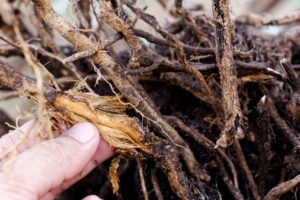
The telltale sign of overwatered weed is droopy & dark fan leaves. Cultivators may also notice their overwatered cannabis plants aren’t growing as quickly as they should. If overwatering is severe, you may start to notice the fan leaves turn yellow. However, yellow fan leaves could signal other issues like a pH imbalance or nitrogen deficiency. Please read our “Yellow Fan Leaves” guide to better understand this issue.
If you fear you’ll overwater your cannabis plants, you should take care to record every time you add water to your pots. You should also double-check that your soil is draining in your container. Adding amendments like perlite could dramatically improve water drainage, so be sure to inspect the concentration of ingredients in your potting mix.
People who know they have issues with overwatering should be extra strict with how much water they give their plants. Indoor cultivators may also want to err on the side of “less is more” to reduce the risk of overwatering.
Is Underwatering Common For Indoor Cannabis?
As we just mentioned, overwatering is more common for indoor cannabis growers than underwatering. However, that doesn’t mean underwatering is impossible.
When cannabis plants don’t have enough hydration, they will start to signal warning signs like wilting and burnt leaves. As underwatering progresses, you may notice these fan leaves turn a shade of yellow and your cannabis plant will probably stop growing.
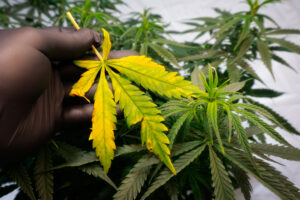
Obviously, the best solution for underwatered weed is adding more water to your schedule. You may also need to consider the water retention levels in your soil. Some soil ingredients like pea gravel add extra drainage at the expense of water retention. Always be sure your soil mix is well-balanced so it will hydrate your plant’s roots without submerging them in water.
Does Soil Affect A Cannabis Watering Schedule?
Often, indoor cultivators who think they have a “watering problem” have an issue with their soil. Your soil may not have the proper balance of water retention and drainage to develop a healthy cannabis plant. This is especially true for new cultivators who start experimenting with “living soils” that have tons of fertilizers and organic matter.
Typically, loamy potting soil is the ideal choice for beginner cannabis cultivators. These soil varieties tend to have the best balance of water retention and drainage to keep your plant’s roots hydrated without risking root rot.
If you need more detailed info on choosing the best cannabis soil for your grow space, we recommend reading our previous post dedicated to “The Best Cannabis Soil Types.”
Isn’t There A More Scientific Way to Tell If Cannabis Needs Water?
For those who crave precision when watering their cannabis, you may want to investigate tools like a soil moisture meter. These devices will give you a reading on the water concentration in your soil. So, if you can’t trust your skills at feeling your soil for dryness, a soil moisture meter may provide a more accurate measure.
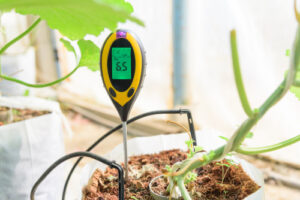
You shouldn’t have an issue finding reliable soil moisture meters in garden shops or pro gardening websites.
Keep Hydration High On Your List For Cannabis
Along with light and nutrients, water is one of the essential features every cannabis strain needs. However, since everyone knows cannabis plants need water, there’s a tendency to overwater indoor flowers. If people are new to indoor cannabis cultivation, it’s safer to water slightly less than they think is a “fair amount.” Sure, water is essential for cannabis growth, but most people avoid issues like root rot by deliberately using a light hand with their watering jug.
As a final tip, please remember that “watering issues” aren’t always related to water. You may not be using the best pot size or material for your cannabis strains. It’s also possible your soil’s amendments may retain too much water. Always take note of these secondary considerations if you’re struggling with your plant’s watering issues.

Leave a Reply